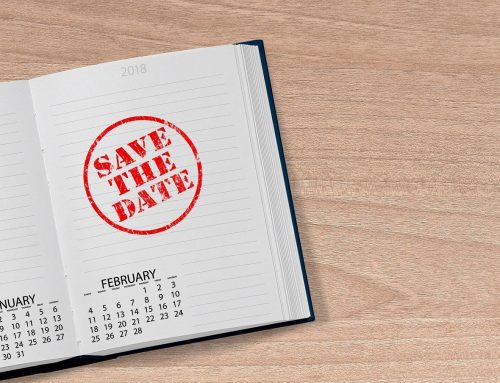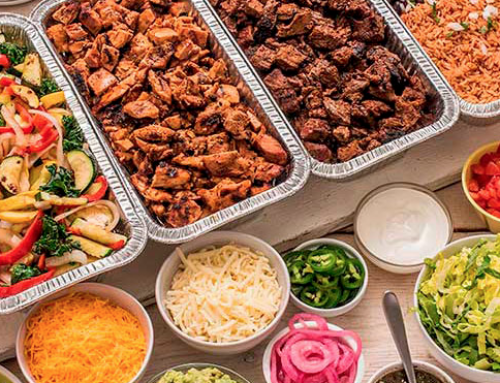What equipment will you need to start a catering business? Our goal is to answer all your catering equipment questions from the pricing, how each tool is used, and even setup considerations inside one epic post. By the end of this article you’ll understand the exact equipment you need, don’t need, and what you can rent instead of buying to save you money.
Finally, we provide a downloadable Excel spreadsheet at the bottom of this page you can download, save, and refer to when building your custom catering equipment list. Keep in mind, your finalized equipment list will vary from the example on the bottom of the page based on your unique menu.
Determine Your Catering Menu
Before determining the catering equipment you need to buy, you need to figure out your menu. Just like a restaurant, you want to stay in your lane so to speak with a food concept. Not only does keeping a consistent menu help you become a master of the food you serve, but you won’t need to invest so much money in equipment that you might only use for one event.
You might already recognize catering businesses specialize in menus serving BBQ, Hawaiian, Mexican, or Italian foods. The first step is to figure out what kind of menu where you plan to specialize. You’ll be able to tweak your menu based on customer tastes or requests, but sticking to a high-level theme is important. It’s impossible for you to be great at cooking and serving every type of food under the sun. Don’t fall into the trap of having something for everyone or you won’t ever build a catering business that’s truly memorable!
Related Reading: How I Started a Legit Catering Business Out of My House
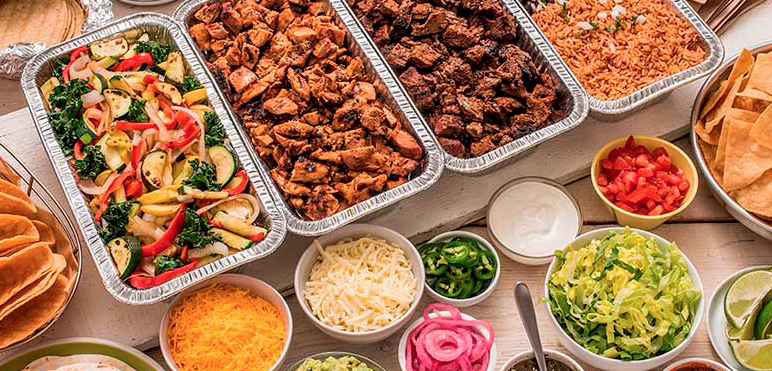
Catering spread for a Mexican food concept.
Determine Size of Catering Events
Different catering businesses serve different sizes and audiences of people like corporate events, weddings, tailgating, or birthday parties. The typical wedding caterer won’t serve more than 200 guests regularly. Many food businesses start by serving small groups of 50 people or less. The smaller your catering event, the less equipment you need and easier it will be to get started. As a rule of thumb, we recommend starting with a small catering events first. This will help you build up your confidence and experience before tackling the bigger and more lucrative gigs.
Get to Know Local Event Rental Companies
Don’t break the bank by purchasing all your catering equipment at once. In fact, there’s a lot of equipment you may never need to purchase. As a caterer it’s in your best interest to get to know your local event rental companies. The easiest way to find options near you is to visit Google and type event rental companies into the search field to locate what’s available near you.
You can rent just any piece catering equipment you need from these supply businesses. In fact, while you’re still in the planning phase of your business it’s worth spending an afternoon visiting these shops to explore what’s available for rent and take notes on the different pieces that could work for each type of events. As your business grows, you could find yourself serving casual locations like birthday parties to a weddings so it’s important to understand the spectrum of items available to rent.
Below are items you can expect to find at a party rental shop. If you’re reading this now, you’re probably in the early days of your business and starting out on a budget. With this important consideration in mind, we recommend renting the high-ticket items. Here are some catering equipment pieces you should be renting (at first):
Tents: To purchase even a small tent or canopy will set you back a few thousand dollars. A larger tent popular at weddings might be tens of thousands of dollars to purchase. Then you’ve got to find a place to store it while the item is not in use. As a result, you’ll want to rent these until you’re confident you have regular catering business coming in.
Seating: The style and size of seats will differ based on the type of catering event. Benches will work better in some locations while folding chairs might be just fine for a corporate picnic. Since seating is a variable decision, rent it instead of buying.
Banquet Tables: You will likely want to buy one or two banquet tables yourself since this is an item you’ll be using frequently and will need on hand. In the event you’re planning a larger service with more tables needed, renting is an easy and affordable option to fill the gap.
Sound / Visual Equipment: This is rare, but you may be asked to provide lighting or sound for an event. You can find this equipment here as well. Note: These responsibilities are typically handled by an event planner and not a caterer.
Be sure to ask the catering customer what need at the event before renting any equipment. Build simple questions like “Do you need seating?” into your catering intake process. If you take the time to communicate with customers and ask these basic questions you’ll save yourself a lot of time and headaches.
Many of your catering events won’t require you to bring any seating at all or tables at all. For a casual corporate lunch, you will only need to deliver the basics: food in foil pans, large plastic spoons to serve, and make plastic cutlery / napkins available. All the food will be laid out on a conference table and diners will serve themselves. Make sure to ask if seating or tables are needed before going through the hassle of bringing tables and chairs.
Finally, for any equipment that needs to be rented you’ll need to charge a service fee or rental charge to pass this expense on to the customer. If a customer asks about a service fee in a catering proposal, you can explain that it’s a service fee needed to pay for a convenience of offering seating, tents, etc. Most customers will find this acceptable after the reasoning is explained. It’s also worth noting what a service fee is for inside the proposal.
Some customers may want to negotiate the service fee. Negotiating a fair price is fine. Nobody wants to pay more than they need to for services. But you should never accept a catering opportunity that doesn’t make financial sense for your business. This may mean saying no to certain opportunities.
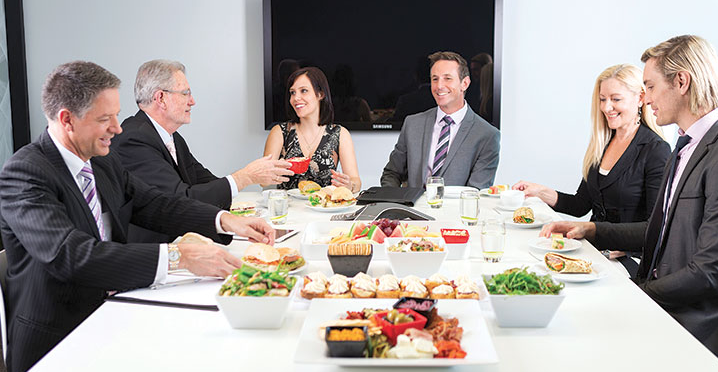
Corporate catering can be a lucrative approach to this business model.
What Kinds of Catering Utensils Do You Need?
The catering equipment you’ll need to pull off a successful catering gig fall into five categories: serving equipment, buffet equipment, beverage station, storage / travel, and presentation. We dive into the details of each category below. If you want to jump straight to the checklist, scroll down to get the free spreadsheet now.
Serving Equipment
As the name suggests, you need tools to serve food. This type of equipment includes a whole bunch of frequently used items like tongs, serving spoons, forks, knifes, and plates. We recommend purchasing these items instead of renting serving equipment since you’ll get ROI on this investment. You’ll use these utensils over and over for years to come so it makes sense to own these pieces.
Buffet Equipment
If you’re starting a catering business, you’ll probably host buffet style events. Buffet style has a lot of cost advantages to caterers since the amount of labor needed to pull it off is a fraction of the cost for table service. Most customers will appreciate the lower cost option too. Buffet equipment that helps you setup a professional buffet line includes big plastic bowls for serving cold items, heat lamps, linens, and chafing dishes.
Beverage Station Equipment
While entrees are the stars, don’t forget about offering beverages too. Hot and cold beverages are the highest margin products you can offer as a business owner. As a result, you should always offer coffee, tea, lemonade or other drinks that make sense with your food concept. We also recommend investing in low-cost water carafes to add a touch of elegance to your beverage service or station.
Food Storage / Travel Equipment
In most scenarios, you won’t cook food on-site at the event. As a result, you’ll need equipment to keep food items hot or cold when traveling from point a to point b. Most professional caterers use insulated Cambro storage products to transport foods all all types. These can be expensive to purchase in the early stages of your business so we recommend renting these products initially.
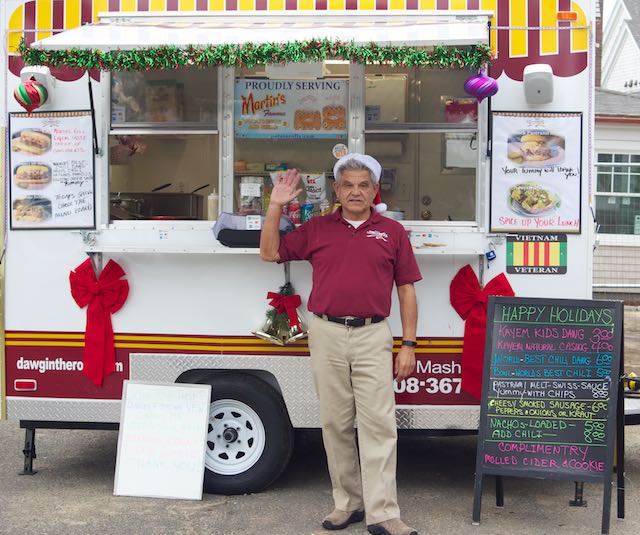
Food truck vendors combine often make over 25% of annual revenues from catering.
Presentation Equipment
Don’t make the appearance of your catering event an afterthought. After all, everyone eats with their eyes before their mouth. Developing a welcoming style will set you apart from other area caterers that completely miss this obvious point.
Making the food you serve look good, will make it taste better to guests. Putting your best foot forward will aid business development too. People will be more likely to refer you and take photos of the awesome display the caterer organized for their special event. Best of all, many of the little touches you use to enhance the overall presentation can be used again and again. Investing in these pieces won’t break the bank either!
Chalk Board – If you’ve got above average handwriting, using a chalk board is an elegant way to enhance the presentation of a buffet line or drink table. Alternatively you could list the reason for the celebration: “Happy 40th Birthday Jack!” These simple touches will be appreciated by your customers and show you really care about the event.
Vintage Letter Board – This is a better option if you’re less artistic. You’ve seen inspirational letter boards with inspirational quotes on Facebook or Pinterest. You can use these same boards to list menus or make a statement at your event. Pro tip: Make sure to buy a board with the letters included to ensure they fit.
Water Carafe – These are both functional and attractive. Not only can you use a carafe or Decatur to serve drinks, but they provide a higher-end aesthetic without breaking the bank. Pop a lemon into these carafes if you would like to add an extra splash of color to the overall event. You can purchase a set of 1 liter glass carafes for well under $20 on Amazon.
Listed above are affordable items you can use to improve the ambiance of an event, but don’t stop there. Look for ways to improve the vibe of catering events by looking at your menu. Offer Hawaiian BBQ? Spread some island like flowers across the buffet tables. Doing more of a Western themed event? Tastefully place a saddle or cowboy hat in the room. Serving a carnival themed party? Time to blow up some balloons! This extra attention to detail will set you apart from all the other area caterers.
Catering Equipment Checklist
| Catering Equipment Checklist | Use | Estimated Rental Cost (Per Event): | Price to Buy: |
| Heat lamp | You can keep meats and other food warm on a buffet line. | $22.00 | $70 – $200 |
| Heat lamp w/ meat carving station | Keep meat warm and cut portions based on request. | $32.00 | $400 – $600 |
| Dinner Plate Cover | These cover plates and keep food warm for formal events. | $0.40 | $15 – $40 per cover |
| Ice Table (Beverage Station) | Used to keep bottles and cans cool. Coolers can also be used. Serves as a beverage station. | $32.00 – $100 | $600 – $2000 |
| Coffee Beverage Container | Container keeps coffee hot and has self-serve nosel. | NA | $87.48 (Pack of 25) |
| Insulated Cambro Food Transport | Holds food pans. Keeps food hot or cold while traveling to event. Must have. | $34.00 | $200 – $300 |
| Chafing Dishes Full Size – Stainless Steel | Must have. Keep food at proper temperature. | $15 | $50 – $200 |
| Chafing Fuel | Fuel to keep water pans hot for food storage. | NA | $50.49 (Pack of 72) |
| Aluminum Foil Pans | Used to hold cooked food and fit in Cambro holding units. | $50 – $75 | |
| Bus Boy / Flat Ware Tub | Used to pick up plates and utensils after dining. You see bus boys using this in restaurants. | $2.50 | $10 – $25 |
| Plastic Bowls | Good way to serve cold items like macaroni salad. | $3.00 | |
| Portion Cups | Four-ounce portion cups with lids. Attractive and fast to serve. | $10.25 (Pack of 100) | |
| Plastic Cutlery & Plates | Spoons, forks, knives. Buy at warehouse like Costco. | N/A | $15.00 for set of 50 |
| Napkins | Heavy duty napkins can be found at most warehouse stores like Costco. | N/A | $51.08 for 6,000 napkins. |
| Baskets | Buy to use for buns, rolls, or bags of chips. | $2.00 | $26.00 for two. |
| Condiment Trays | If serving burger or hotdogs, you’ll use to hold tomatoes, lettuce, and other items. | $19.95 – $30.00 | |
| Linens | These will usually be rented. Contact event planner for advice here. | ||
| Coolers | Great for cold drinks on ice during summer. Also good for parishable transport. | $200 – $300 | |
| Tiered Cake Stand | Rent this for weddings as needed. Cake sizes are variable. | $10 | $23.20 |
| Tongs and Serving Spoons | Steel or heavy-duty plastic will work well for serving. | Variable. | |
| Disposable Gloves | For safety purposes when serving / preparing food. | NA | $10.00 |
| Water Carafe | Serve water and other beverages in an attractive way. | $1.00 | $8.00 – $15.00 |
| Chalk or Letter Board | Attractive way to list your catering menu. | $2.00 | $15.00 – $40.00 |
More Reading: The Most Profitable Catering Event I’ve Ever Done
Download Excel Spreadsheet Here: Catering Equipment Checklist
Hiring Staff
Although not a piece of equipment, don’t forget that you’ll need help pulling off a large catering event. Any catering event has a lot of moving parts and you won’t be able to do everything yourself once you start doing events with 30 guests or more.
Between traveling from the commissary kitchen to the venue, discussing of the event details with the customer, food preparation, buffet setup, and answering questions it’s impossible to wear every hat and keep your sanity. At the very least you’ll need a helping hand to assist in the delivery of food and setup. Don’t forget that in addition to listing the catering utensils you need, you should do the same for the different roles you need to hire inside your business. Even though these hires will be part-time, start preparing for your list of labor needs now.
The Final Word.
We hope this commonly used equipment checklist makes starting catering business easier. Don’t forget, your food specialty will determine the additional equipment required to operate your business. You’ll need to do additional brainstorming to identify each tool of the trade inside your business.
In the coming weeks, we will be publishing more cutting-edge guides for starting a catering business. Check back this post often and we’ll have ever more valuable resources like catering agreements and proposal templates to help you run your business.


